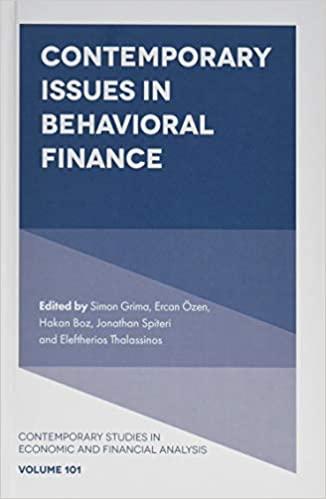Question
4) A Morgan Stanley analyst produced the financial forecasts provided in the attached Excel file shortly after the offering. The analyst assumed a WACC of
4) A Morgan Stanley analyst produced the financial forecasts provided in the attached Excel file shortly after the offering. The analyst assumed a WACC of 9.7% and 1,404 shares outstanding. Under these assumptions, what would be the discounted cash flow (DCF) estimate of Snap stocks fair market value on a per share basis?
- What discount rate would you recommend using in this DCF analysis? Assume a long-term government bond rate of 3.16%?
- How, in particular, would you deal with the uncertainty associated with Snaps future growth?
-
a. How sensitive is this estimate of Snaps stock price to assumptions about growth and WACC?
-
b. Do the assumptions and forecasts appear reasonable? What data would you use to assess that?
-
c. Analyze Snaps DCF value under various alternative assumptions of your own.
-
- What important changes would you make to the forecasts provided by Morgan Stanley, if any?
- What discount rate would you recommend using in this DCF analysis? Assume a long-term government bond rate of 3.16%?
- How, in particular, would you deal with the uncertainty associated with Snaps future growth?
-
d. Do you believe that Snap under-priced its IPO? If so, why might it have done, and would you agree with that decision? If you were the CEO of a company undergoing an IPO, would you agree to under-price it at the time of the offering?
-
Snap DCF Analysis 2014 2015 2016 2017E 2018E 2019E 2020E 2021E 2022E 2023E 2024E 2025E Terminal Year Net revenue 58.7 404.5 943.7 1934.7 3254 4901.7 6907.3 9188.5 11635.3 14130.6 16568.9 17148.8 % change Y/Y 589.50% 133.30% 105.00% 68.20% 50.60% 40.90% 33.00% 26.60% 21.40% 17.30% 3.50% Adjusted EBITDA -292.9 -459.4 -771.9 -609.5 -194.6 362.6 1474 2616.1 3887.8 5222.5 6573.6 6803.7 (-)Cash taxes 0 0 0 0 0 0 0 0 0 823.3 1448.4 (+/-)Changes in working capital -15.5 -150.5 -256.6 -227.5 -230.5 -228.4 -208.9 -223.8 -248.1 -206.9 -150.6 (-)Capex 28.3 67 82.6 96.6 109.1 120.1 130.1 140.1 148.1 155.1 161.1 (-)Stock-based compensation 73.5 31.8 75 159.3 202.8 256.5 316.6 421.1 533.3 647.7 759.4 Free Cash Flow (for valuation) -410 -709 -1186 -1093 -737 -242 818 1831 2958 3390 4054 4196.1 % of revenue 70047.8 EBITDA margin -499.0% -113.6% -81.8% -31.5% -6.0% 7.4% 21.3% 28.5% 33.4% 37.0% 39.7% 39.70% Incremental EBITDA margin -48.20% -57.90% 16.40% 31.40% 33.80% 55.40% 50.10% 52.00% 53.50% 55.40% UFCF/EBITDA 140.10% 154.30% 153.70% 179.30% 378.70% -66.90% 55.50% 70.00% 76.10% 64.90% 61.70% 61.70% DCF Valuation Assumptions WACC 9.7% Perpetual Growth Rate 3.50%
Step by Step Solution
There are 3 Steps involved in it
Step: 1

Get Instant Access to Expert-Tailored Solutions
See step-by-step solutions with expert insights and AI powered tools for academic success
Step: 2

Step: 3

Ace Your Homework with AI
Get the answers you need in no time with our AI-driven, step-by-step assistance
Get Started


